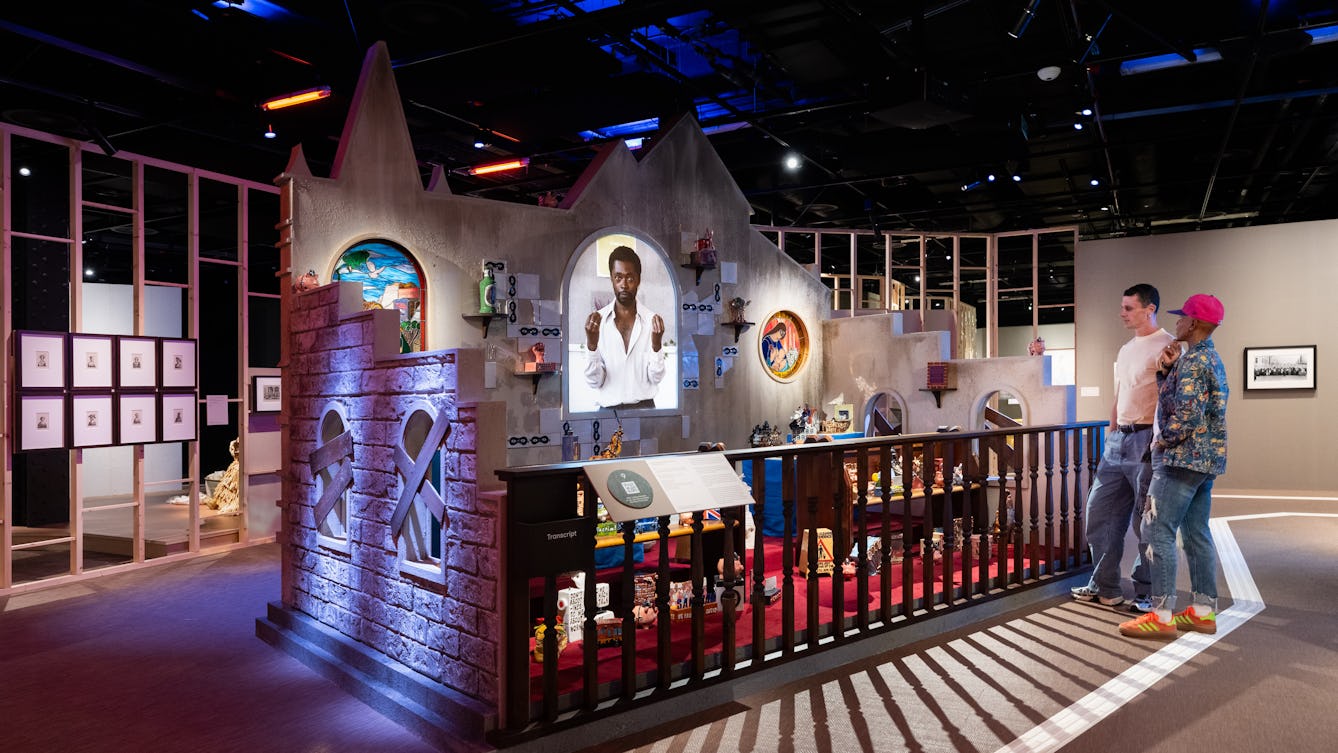When facing this work, there is a yellow fabric bench behind you.
Hello, my name is Lindsey Mendick. I’m an artist based in Margate.
My installation is a stage-like set representing a church. I wanted to reclaim the church as a sanctuary for the stories and the histories of sex workers, which are represented by ceramic moneyboxes occupying the church.
Over 4.5 m wide and 2 m deep, the roofless structure has three walls, reaching about 3 m high at their tallest point. The fourth side is open behind a wooden altar rail. The left half of the church is painted as grey stone, while the right half is red brick, giving the impression of two churches fused together. The facade boasts bricked-up doors and double steeples; high in the centre is a pink neon sign that reads “Workers, Workers, Workers”. Inside, clusters of ceramic tiles and two stained-glass windows flank an arch-shaped video projection in the back wall’s centre. Around 60 elaborately decorated ceramic moneyboxes of different shapes and sizes are scattered around the interior, perched on pews, shelves, plinths, and the floor. They are each 20 to 30 cm high.
I developed this installation with sex workers from SWARM – the Sex Worker Advocacy and Resistance Movement – and the author Mendez. SWARM is a UK-based sex-worker-led collective that campaigns for the rights and safety of everyone who sells sexual services.
We wanted to show the realities of sex work and the stories and histories of sex workers. Sex workers aren’t being listened to; laws meant to protect them often don’t reflect what they need to work safely. In the UK – except for Northern Ireland – it’s legal to buy and sell sex, but advertising sex, kerb-crawling, and working indoors with another sex worker are all criminalised activities. Being fined or imprisoned makes it harder to leave sex work. Stigma can also lead to discrimination when accessing healthcare and other services.
The moneyboxes point to the main reason that most people sell sex: to earn income when other work is unavailable, or too low paid to survive on.
The church is starting to crumble; the four windows on the lower, unfinished side walls are partially boarded up. City streets are always changing, and arrests of sex workers increase with rapid urban gentrification. The media, state and police describe this as “cleaning up the streets” – this language is harmful, suggesting that it’s OK to treat these people like dirt. Sex workers who work on the streets face a higher risk of violence than those who work indoors.
Churches have played a key role in sex workers’ activism. In 13th-century Paris, sex workers built their own chapel, with Mary Magdalene as their patron saint. In June 1975, more than 100 sex workers occupied the Saint-Nizier Church in Lyon, France, for eight days to draw attention to their ‘inhumane’ working conditions. In November 1982, the English Collective of Prostitutes occupied the Church of the Holy Cross in the red-light district of King’s Cross, London, to protest police brutality and racism against sex workers.
In my installation, the moneyboxes become bodies ‘occupying’ the church. They perch on two high-backed wooden pews at the back, peer down from six wooden shelves on the back wall, and congregate on the dark red carpet. Some cluster on four plinths of different heights, the tallest over a metre, behind the altar rail. Upholstered with sleeping bags, the plinths give the impression of cloth-draped altars.
On the lowest central plinth is a moneybox shaped like a pile of limp pizza slices, oozing with tomato sauce and peppered with olives, pepperoni and mushrooms. Atop the pile, a crown of gold letters reads “SWARM” and on the base of the pizza plate, “Suppers”. A red bee, the emblem of SWARM collective, settles on a slice. This sculpture represents the SWARM suppers. They are regular informal meet-ups for sex workers to learn about SWARM’s activism and to enjoy a free meal with their community.
On the leftmost plinth is a money box shaped like a hardback book. On the cover, its gold title, “The Contagious Diseases Act”, sits above a silver vaginal speculum with open hinged arms resembling a pelican’s beak, to the left of the gold words “Steel Rape”. The book’s pale fleshy cover is marked by syphilis sores. A wrinkled penis protrudes from the book’s top and a vulva blooms along its spine. In the 19th century, Contagious Diseases Acts gave the British government the right to detain any woman suspected of being a sex worker and forcibly examine her for sexually transmitted illnesses.
In the centre of the church’s back wall is a colour video projection of author Mendez performing a sermon they wrote. Mendez, a Black non-binary person with a short Afro, trimmed beard and gold pendant earrings, was raised within the Jehovah’s Witness faith and formerly worked as a sex worker, becoming estranged from their church and family.
On either side of the video is a stained-glass window, multicoloured light filtering through. The 60 cm-wide circular window on the right depicts a mother with long brown hair nursing a child, her pale breast peeking out from a cobalt-blue gown. Reminiscent of baby Jesus and his mother Mary, the pair are flanked by tall lit candles and white flowers. The mother wears an eye mask to protect her identity. A yellow border around the window bears the defiant calligraphy inscription: “Hands off our children, we don’t want our kids in care.” Globally, most female sex workers are also mothers.
This is the end of Stop 9.
